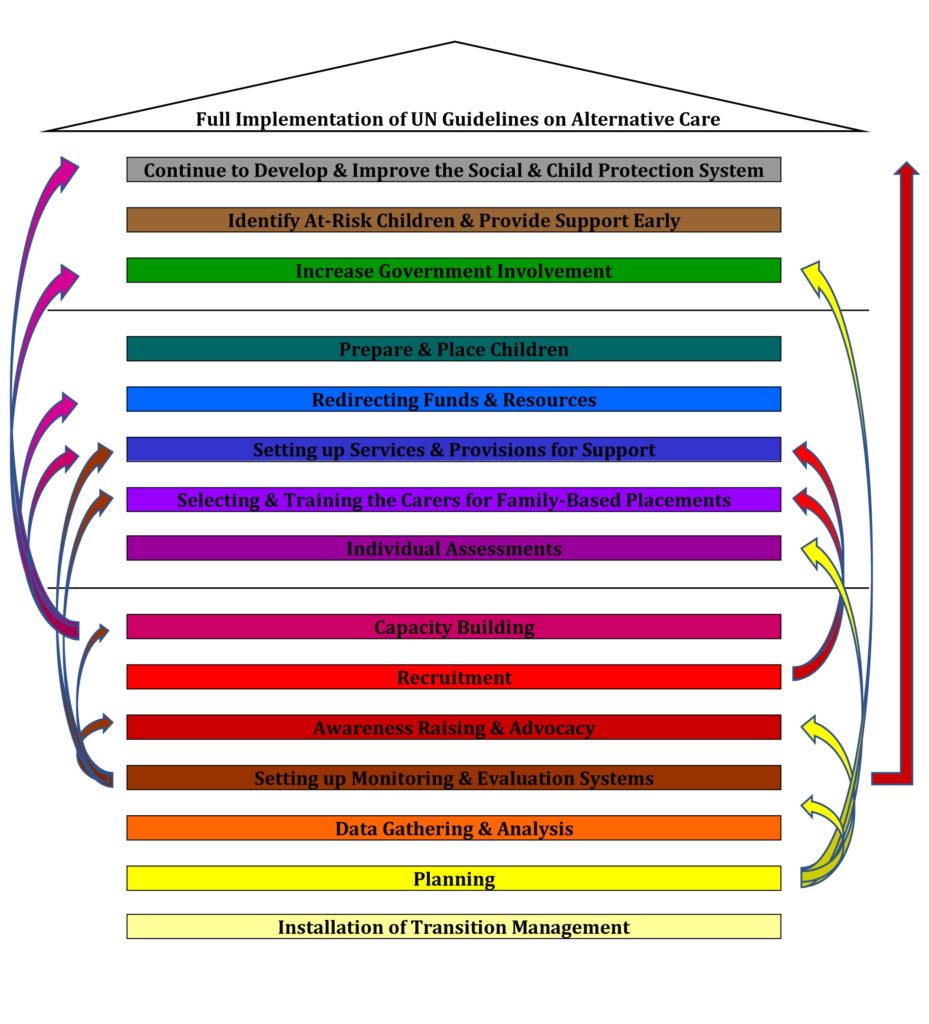On 30 March, I shared the Theory of Change model to achieve full implementation of the UN Guidelines on Alternative Care for Children with you (HERE). As I mentioned then, I currently do not have the funds to publish this model with its explanation. The fundraiser on GoFundMe to bring together these funds needed has not been terribly successful to date. And yet I do want to make the explanation that goes with the model available to people. So, I have decided to cut the explanation up into pieces and to share it (in a slightly abbreviated version) with you in blogs over the coming weeks. It will cover many topics that have come past in the blogs so far but in a more structured way. Today, the introduction to the explanation of the model:
Over the past 50 years, awareness of the harm caused by institutionalising children has gradually sunken in and started spreading globally. In the past decade or two, the pressure to move away from institutional care has been rising on all countries.
Just over 30 years ago, the UN brought out the Convention on the Rights of the Child, and this included the stipulation that institutional care should only be used as a last resort. However, after a decade or so, the Committee on the Rights of the Child found that while this stipulation was present, individual states struggled to work towards this, without more concrete information on what they should do. Therefore, a new document was commissioned, which came out 10 years ago this month: the UN Guidelines on Alternative Care of Children. These guidelines provided more information about the requirements for alternative care. However, while this document gave very valuable information and a much clearer picture of what countries should be aiming for with regards to their alternative care system, it still did not give information about how to get there.
In 2007, Mulheir & Browne wrote ‘De-Institutionalisation and Transforming Children’s Services: A good guide to practice’ for the Daphne Programme of the European Commission. In this document, they laid out ‘ten steps’ that need to be taken in the deinstitutionalisation process. This overview brought forward a lot of issues that need attention in this transition process that are often overlooked or underestimated. Georgette Mulheir went on to become the CEO of Lumos foundation and that organisation further developed the ‘ten steps’ into ‘ten elements of the transition of care’. Together the original document and the system developed by Lumos provided much more of a handle on what the process of deinstitutionalisation entails.
However, in the practice of daily life, it seems that more is needed. When I am guiding a move from institutional to family-based alternative care, I provide training on the ten steps or elements, to help people understand what is involved. This knowledge is always welcomed and is felt to give a much greater understanding of the process. However, when it comes down to it, I find people looking around and scrambling to figure out what the next concrete step is to take now. They understand that something needs to be done about awareness-raising and situation analysis and redirecting resources, but right now, what is the next action to take?
This is what has made me decide to develop a kind of Theory of Change model where the process is broken down into actions rather than areas that need attention. Of course, being a model, it does not come close to breaking things down to individual actions. Instead, it indicates what issue needs to be addressed at what point. This will hopefully give people involved in the move from institutional to family-based alternative care enough of a guide to fill in the last details, relevant to their particular situation, themselves.
The aim of the model is to allow it to be used at different levels. The issues mentioned can be scaled up or down to either apply to a national move towards family-based care and family strengthening, a district-level move, or the grassroots deinstitutionalisation of a single institution. In the following explanation, mention will be made of any differences of approach to an issue at different levels. When you are working on the national level, you have to be aware that you are starting a process that will take many years to accomplish and that will often proceed at different speeds in different locations. It will generally require establishing a pilot programme in one or two locations first, and then to gradually roll this out. You may have to manage being at different stages of the process in different locations, at the same time.
The model pays a lot of attention to various stages of deinstitutionalisation because the reality is that in the majority of countries, this is an essential part of fully implementing the UN Guidelines. However, it is also possible to use the model if there is no residential institutional childcare in your country or if deinstitutionalisation has been completed, but the development of social and child protection systems still need work, and family-based alternative care is not fully functioning yet. Not all issues mentioned will be relevant in this case, but many will be.
After stating and explaining the goal of this model, the explanation will start at the bottom of the model and work its way up towards achieving that goal.

If you want to read the full explanation with the model, just click on the link in the bottom right corner at the end of each blog, to take you through the whole thing.
Please share this blog to help spread awareness.

